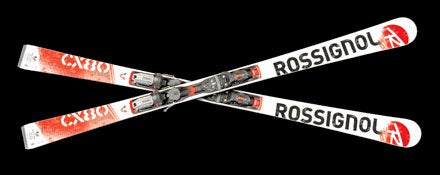1. Most frontside skis are too precise and exhausting for freeskiing. Not the pared-down CX 80, which does away with heavy add-ons like complex binding plates for a more responsive feel. It’s ten millimeters fatter than most, but its World Cupinspired laminate construction and vertical sidewalls still deliver impressive edging.
2. Baby got back. That extra girth underfoot makes the CX 80 less twitchy at high speeds and lets you float turns in boot-deep powder or mushy spring snow. It also gives you a bigger platform to stand on when you’re taking it easysomething you can’t do on most carving skis.
3. “Frontside skis need to be dynamic, or we’d all die of boredom,” said one tester. “These skis satisfy.” Credit the CX 80’s 16.5m-radius sidecut and wood-core guts. The harder you drive it, the more it responds, letting you confidently arc multiple turn shapes.
4. Rossignol claims you can ski the CX 80 off-piste 30 percent of the time. And while the CX 80 is in fact slinky enough for bumps and can handle chopped-up crud, we’d keep this one as our go-to groomer and pair it with a big-mountain ski instead.
5. Compromise is a delicate art, but this ski nails it. The CX 80 feels supple in the bumps but powerful on corduroy, precise in the chutes but forgiving in the crud. And wherever you are, the CX 80 is rock solid and unwavering at any speed. Even the old-school graphics make you want to go fast.
124/80/113, $1,400, binding included,
Mountain Hardwear Kramer Resort Jacket
Mountain Hardwear Kramer Jacket
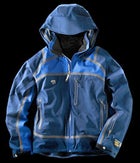
1. This hybrid jacket uses soft-shell material on most of the body, which gives it a slightly stretchy athletic feel and fit. But because it’s seam-sealed and reinforced with waterproof-breathable (hard-shell) nylon panels in strategic placeslike the hood and the tops of the armsthe whole package repels precipitation without getting too steamy.
2. For in-bounds forays, the Kramer has you covered, with an iPod pocket, powder skirt, and pass holder with keeper cord. And because most of the body is lightly insulated, with additional swaths of fleece along the tops of the arms, it kept testers plenty warm despite single-digit temps and high winds in Kicking Horse, British Columbia.
3. Bluebird day, heading out the gate, or just going for a cool-weather hike? Strip away the powder skirt as well as the detachable (and helmet-compatible) hood. Despite ample pit zips, the Kramer is too warm for spring touring or aerobic sprints up the mountain. But it’s plenty breathable for mellow boot-packs and more relaxed (or colder-temperature) tours.
1.9 lbs, $330
Gnu Altered Genetics Snowboard
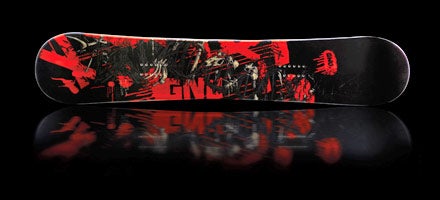
1. The AG is one highly engineered board, but all that technology disappears when you hop on it, and this directional twin-shape was our favorite all-mountain board.
2. Heavily reverse-cambered boards, with a rocker shape from tip to tail, can be a little squirrelly for riders used to traditional decks. But with a subtle take on the design, the AG is just right: It floats through powder, soaks up chop, and cruises groomers with ease.
3. While most boards have just one consistent sidecut, the AG’s sidecut is strategically scalloped in spots. This design, called Magnetraction (and first developed with Gnu’s sister company, LibTech), means more contact points with the snow, which translates to extremely quick edge-to-edge transfer and stronger hold when tearing down groomers.
4. The board’s namesake core is made of a genetically engineered aspen/bamboo/balsa hybrid that grows in a single tree. Testers liked the mash-up: “Tremendous takeoff strength and tons of pop when unloaded,” said one. The core is a bit lighter than most, too, “which made spinning effortless,” said another.
5. In addition to the sustainably harvested core, the topsheet is an earth-friendly polymer, made of castor beans, that boasts one of the highest strength-to-weight ratios in the industry.
$600
Movement Goliath Backcountry Skis
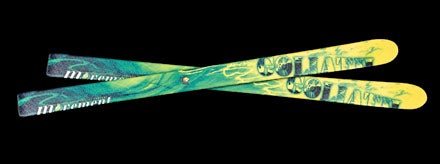
1. All skis this plump are a blast in powder, but the Goliath won our Gear of the Year award for its performance on firmer snow. During test conditions that ranged from teeth-rattling hardpack to boot-deep powder to crusty leftovers, the Goliath simply outperformed every other ski in its class.
2. The key to its hard-snow agility is a rubber plate placed between the wood core and the retention plate in the middle of the ski. Movement claims it improves the Goliath's ability to absorb vibration by 50 percent. Our take, as summarized by one tester: “It had the best edge hold of any fat ski I've ever tried.”
3. The other key to its hard-snow performance is the Goliath's beech-poplar-and okume-wood core, which has incredible damping qualities and a high strength-to-weight ratio. Plus all the wood is select round timber from forests certified sustainable by the Forest Stewardship Council.
4. With its long 32m turn radius, the Goliath is especially stable making sweeping arcs at speed. But thanks to an “early rise,” or slightly upturned, tip and a snappy feel overall, it's surprisingly agile edge to edge on hardpack and making quick turns in the trees.
5. Unlike most larger ski manufacturers, Swiss upstart Movement owns its factory, which is in Tunisia, thus affording the company total control over its products, from materials to designs to construction techniques. Movement skis may cost a bit more than those from the major brands, but they're worth it.
135/108/124, 10 lbs, $1,000
Patagonia Icefield Backcountry Jacket
Patagonia Icefield Backcountry Jacket
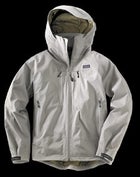
1. No matter what the weather, the Icefield was ready. The shella slightly stretchy, very sturdy ripstop polyester with a waterproof-breathable membraneshucked off epic dumps at Jackson Hole and wet slop on Washington’s Mount Baker. But inside was the perfect amount of Climashield Green insulation to keep us warm when the winds blasted us on the lifts at Loveland, Colorado. Yet on full-speed boot-packs up Aspen’s Highland Bowl in midwinter, the Icefield felt light, breathable, and comfortable.
2. What makes a good jacket great? The details. Here, it’s buttery- smooth zippers, hood drawstrings that vanish into a fleece-lined collar, and reinforced shoulders and hips for carrying skis or a pack. Spacious front pockets held climbing skins or goggles, and generous pit vents helped unload steam.
3. A minimalist design means no extras like a pass holder or powder skirt but a style that feels as comfortable at the bagel shop as at the lift line. It’s also hard to believe how truly sustainable this jacket is, given how well it performs. Most materials are recycledall of the shell and 40 percent of the insulationand the jacket is fully recyclable.
2.1 lbs, $400
Black Diamond Bandit AvaLung Backpack
Black Diamond Bandit AvaLung Backpack
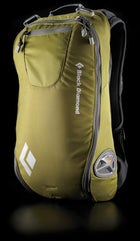
1. Thanks to the 690-cubic-inch Bandit’s low profile, we barely noticed it while riding lifts. And when we wanted to leave the gates or head out for a quick backcountry tour, this pack was the perfect size.
2. The Bandit’s sleek look belies its utilitarian nature. Inside, you’ve got sleeves for a hydration bladder and snow-safety tools, and the back panel’s clamshell opening lets you find stuff quickly. Fastening your skis to the cleverly stashed diagonal ski-carry system is a snap. Our only gripes: It’s not quite big enough to hold larger-bladed shovels easily, and you have to jury-rig it to carry a snowboard.
3. The huge innovation here was the inclusion of an AvaLung in a pack this size. Should you get buried in an avalanche, the device can help you survive up to 45 minutes by redirecting the carbon dioxide you exhale, thus delaying the formation of a suffocating “ice mask” around your face. The AvaLung used to come only à la carte (with just a harness) or in larger packs. Now, finally, it’s available in a pack sized for day trips and short sidecountry excursions. This pack is sold, sans Avalung, for $70 for folks who never venture into avalanche-prone terrain.
2.2 lbs, $170
Pearl Izumi Syncroseek III WRX Trail Runners
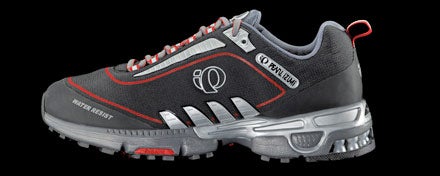
1. The problem with most waterproof trail runners is that they don’t breathe very well. So instead of using a Gore-Tex-like membrane in the Syncroseeks, Pearl Izumi opted for a tightly woven, DWR-treated soft-shell upper, which kept our feet almost as dry as with waterproof shoes, without any clamminess.
2. Stepping in, we had a hard time not saying, “Aaahh.” The seamless one-piece upper means no hot spots and no blisters. And with no mesh or overlays on the upper, there’s nothing hanging out to snag on sticks or roots.
3. Put simply, they run well on all types of terrain. A three-fourths-length plastic frame adds a touch of pronation control and overall stability without clunky stiffness. While the fit is best for wider feet, the 360-degree wraparound laces keep even narrow feet locked down.
4. Our only gripe: the weight. But even at a relatively beefy 14 ounces, this shoe got raves from nearly every tester about its swift feel. “It’s the type of shoe that gets me going fast,” one said. Although the Syncroseek is cushioned enough to save your joints, the rubberized EVA midsole is springy and explosive, not sluggish.
5. Mud and wet rocks and roots weren’t a problem for the low-profile rubber outsole, which impressed testers with its sturdy durability. The plastic frame underfoot doubles as a stone guard, while a solid but not overbuilt toe bumper also protects well on rocky trails.
14.1 oz, $115
Easton Artica Backcountry Snowshoes
Easton Artica Backcountry Snowshoes
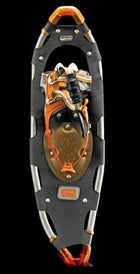
1. From backyard strolls to backwoods epics, the Backcountry was our favorite all-purpose snowshoe. Its frame is really two pieces of aluminum alloy held together at the toe and heel by sturdy, flexible plastic, so the deck self-adjusts to tricky terrain. The inner tail is streamlined to allow a more natural stride on casual strolls but leaves enough float for overnighting with a pack.
2. Like the traction control on a car, two aggressive, pivoting crampons near the toes deliver more grip to the inside or outside of the boots, wherever it’s needed most. Despite all the moving parts, testers reported a snug, secure fit that gave them confidence even when traversing steep hills. The binding’s contoured padding comfortably locks in your boots, and a pivot-stop keeps the tips from banging your shins midstride.
3. All the little extras add up, too. A heel pull-tab makes getting these shoes on and off hassle free, even with gloves. Testers said the bouncy, shock-absorbing plastic heel pad sprung them into each stepand they loved that the shoes are 80 percent recyclable, though they’re clearly built to endure many hard seasons. Bummer: Several testers lamented the lack of a heel lifter, which would have helped reduce fatigue on steep climbs.
(2 lbs; 21”, 25”, 30”) $260




